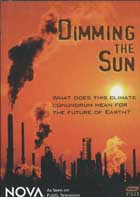
Dimming the Sun: What Does This Climate Donundrum Mean for the Future of Earth? 2004
Distributed by WGBH Boston, 125 Western Avenue, Boston, MA 02134; 617-300-2000
Produced by David Sington
Directed by Duncan Copp
DVD, color, 56 min.
Jr. High - Adult
Agriculture, Environmental Studies, Science
Date Entered: 04/23/2007
Reviewed by John J. Meier, Physical and Mathmatical Sciences Library, Pennsylvania State University, University Park, PADimming the Sun is a broad overview of the lesser known sibling of global warming: global dimming. Due to pollution and particulates in the atmosphere, from power plants to airplanes, less solar radiation is reaching the surface of the Earth. Researchers from all over the globe – Israel, India, Germany, Australia, and the U.S. – explain how their individual research fits into a global phenomenon. There exists a seeming paradox that pollutants are causing cooling and warming of the Earth. The actual result is that if “dimming” contributions can be reduced, helping agriculture and climate, global warming will actually increase over current projections. The heavily narrated program is a combination of documentary interviews, live footage, digital simulations, and dramatic conclusions. It focuses on research but adds drama with tone and montage.
It is a PBS Nova production, credit also to the BBC, so the visuals and sound are impressive and professional. Computer graphics are appropriately used to visualize global and microscopic phenomena. There is a heavy use of montage: using stock footage and clips from “global warming” catastrophe programs with shots of scientific research in action, though results are explained not shown. Some additional features include closed captions and a described video for the visually impaired. On the website there are a few resources including discussions, slide shows, and instructional handouts (including a water evaporation experiment).
I suggest showing this film in conjunction with or supported by a program or book on global warming, though most audiences will have some familiarity with this current topic. A general audience will appreciate the program more than specialists, since most concepts are simply explained and some repetition occurs. The show fits well into one class period, but does not leave much time for discussion or use of the teaching materials unless used over multiple sessions or longer class periods.
I recommend this video for general or current events collections and collections supporting environmental studies.